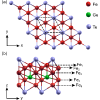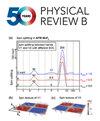Prediction of stable nanoscale skyrmions in monolayer Fe5GeTe2
IF 3.7
2区 物理与天体物理
Q1 Physics and Astronomy
引用次数: 0
Abstract
Using first-principles calculations and atomistic spin simulations, we predict stable isolated skyrmions with a diameter below 10 nm in a monolayer of the two-dimensional van der Waals ferromagnet , a material of significant experimental interest. A very large Dzyaloshinskii-Moriya interaction (DMI) is observed due to the intrinsic broken inversion symmetry and strong spin-orbit coupling for monolayer . We show that the nearest-neighbor approximation, often used in the literature, fails to describe the DMI. The strong DMI together with moderate in-plane magnetocrystalline anisotropy energy allows to stabilize nanoscale skyrmions in out-of-plane magnetic fields above T. The energy barriers of skyrmions in monolayer are comparable to those of state-of-the-art transition-metal ultrathin films. We further predict that these nanoscale skyrmions can be stable for hours at temperatures up to 20 K.

预测单层 Fe5GeTe2 中稳定的纳米级天弧
利用第一性原理计算和原子自旋模拟,我们预测了二维范德华铁磁体 Fe5GeTe2 单层中直径小于 10 纳米的稳定孤立天元。由于单层 Fe5GeTe2 固有的破反对称性和强自旋轨道耦合,我们观察到了非常大的 Dzyaloshinskii-Moriya 相互作用(DMI)。我们的研究表明,文献中常用的近邻近似无法描述 DMI。单层 Fe5GeTe2 中天崩地裂的能障与最先进的过渡金属超薄薄膜的能障相当。我们进一步预测,这些纳米级的天幕能在高达 20 K 的温度下稳定存在数小时。
本文章由计算机程序翻译,如有差异,请以英文原文为准。
求助全文
约1分钟内获得全文
求助全文
来源期刊

Physical Review B
物理-物理:凝聚态物理
CiteScore
6.70
自引率
32.40%
发文量
0
审稿时长
3.0 months
期刊介绍:
Physical Review B (PRB) is the world’s largest dedicated physics journal, publishing approximately 100 new, high-quality papers each week. The most highly cited journal in condensed matter physics, PRB provides outstanding depth and breadth of coverage, combined with unrivaled context and background for ongoing research by scientists worldwide.
PRB covers the full range of condensed matter, materials physics, and related subfields, including:
-Structure and phase transitions
-Ferroelectrics and multiferroics
-Disordered systems and alloys
-Magnetism
-Superconductivity
-Electronic structure, photonics, and metamaterials
-Semiconductors and mesoscopic systems
-Surfaces, nanoscience, and two-dimensional materials
-Topological states of matter
 求助内容:
求助内容: 应助结果提醒方式:
应助结果提醒方式:


